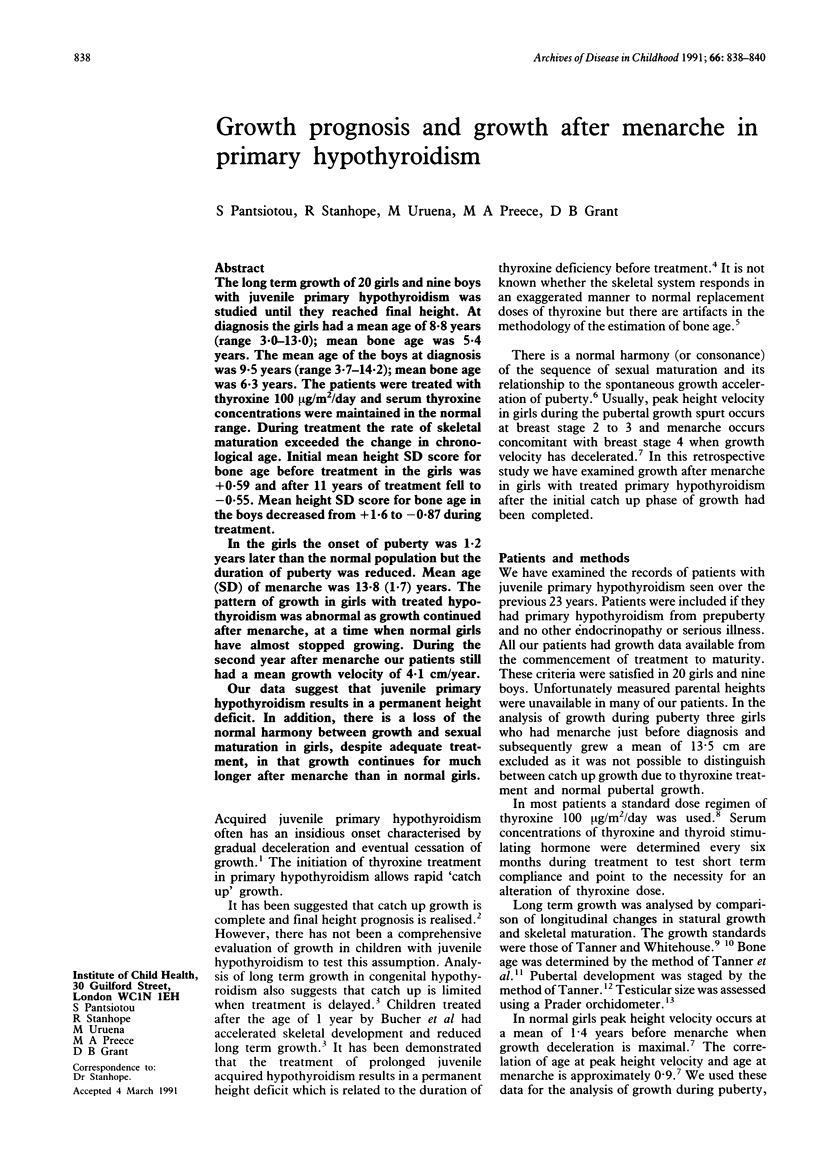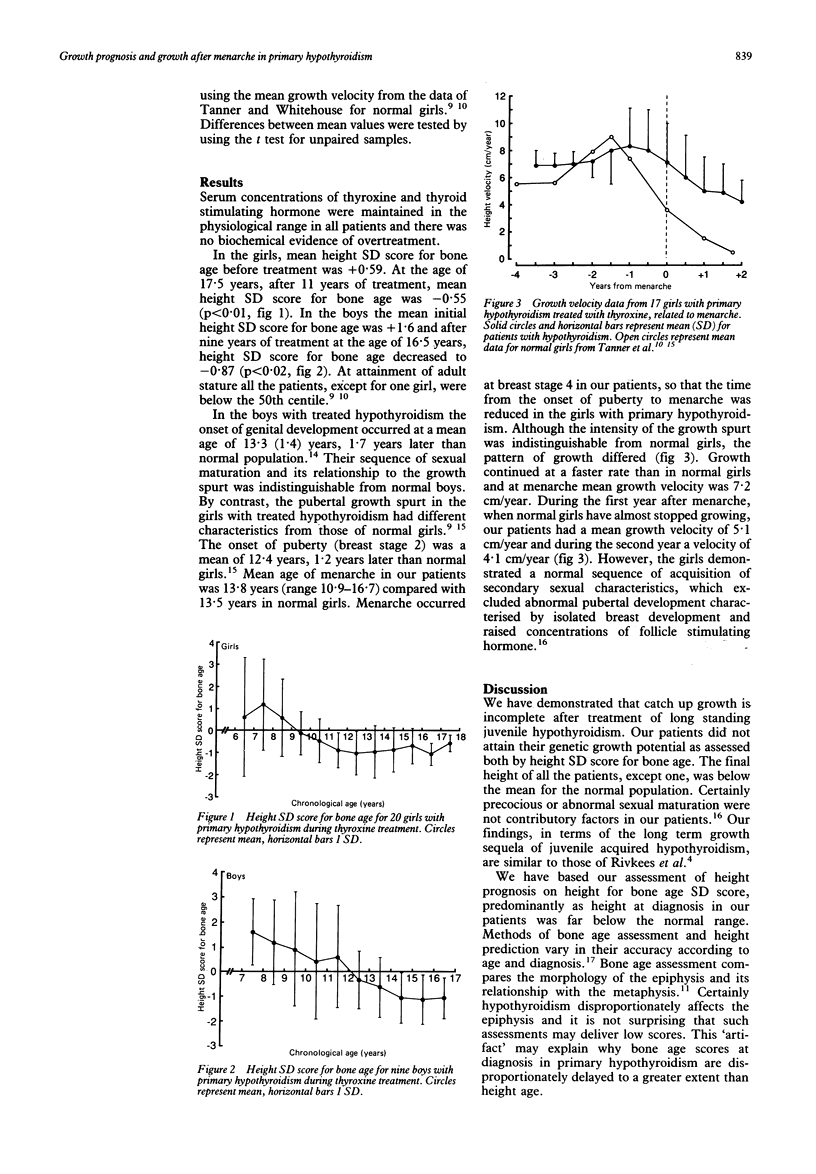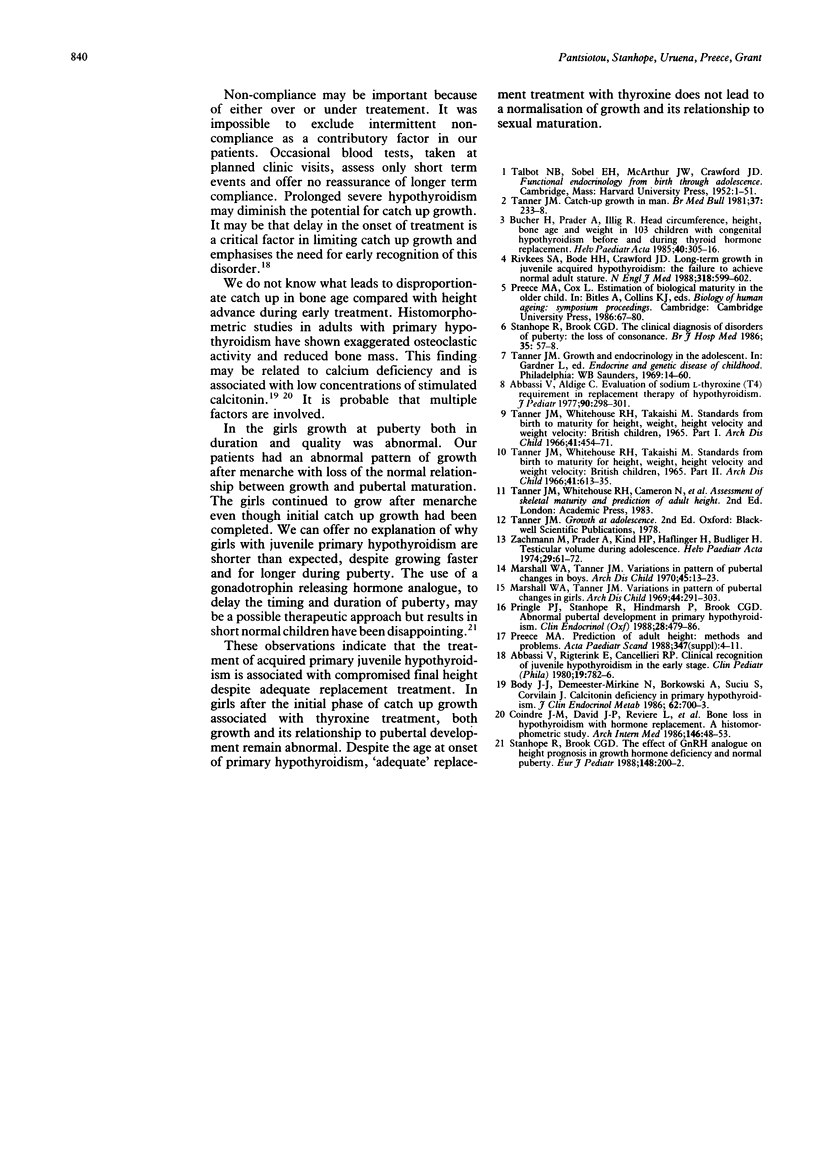Abstract
The long term growth of 20 girls and nine boys with juvenile primary hypothyroidism was studied until they reached final height. At diagnosis the girls had a mean age of 8.8 years (range 3.0-13.0); mean bone age was 5.4 years. The mean age of the boys at diagnosis was 9.5 years (range 3.7-14.2); mean bone age was 6.3 years. The patients were treated with thyroxine 100 micrograms/m2/day and serum thyroxine concentrations were maintained in the normal range. During treatment the rate of skeletal maturation exceeded the change in chronological age. Initial mean height SD score for bone age before treatment in the girls was +0.59 and after 11 years of treatment fell to -0.55 Mean height SD score for bone age in the boys decreased from +1.6 to -0.87 during treatment. In the girls the onset of puberty was 1.2 years later than the normal population but the duration of puberty was reduced. Mean age (SD) of menarche was 13.8 (1.7) years. The pattern of growth in girls with treated hypothyroidism was abnormal as growth continued after menarche, at a time when normal girls have almost stopped growing. During the second year after menarche our patients still had a mean growth velocity of 4.1 cm/year. Our data suggest that juvenile primary hypothyroidism results in a permanent height deficit. In addition, there is a loss of the normal harmony between growth and sexual maturation in girls, despite adequate treatment, in that growth continues for much longer after menarche than in normal girls.
Full text
PDF


Selected References
These references are in PubMed. This may not be the complete list of references from this article.
- Abbassi V., Aldige C. Evaluation of sodium L-thyroxine (T4) requirement in replacement therapy of hypothyroidism. J Pediatr. 1977 Feb;90(2):298–301. doi: 10.1016/s0022-3476(77)80656-2. [DOI] [PubMed] [Google Scholar]
- Abbassi V., Rigterink E., Cancellieri R. P. Clinical recognition of juvenile hypothyroidism in the early stage. Clin Pediatr (Phila) 1980 Dec;19(12):782–786. doi: 10.1177/000992288001901201. [DOI] [PubMed] [Google Scholar]
- Body J. J., Demeester-Mirkine N., Borkowski A., Suciu S., Corvilain J. Calcitonin deficiency in primary hypothyroidism. J Clin Endocrinol Metab. 1986 Apr;62(4):700–703. doi: 10.1210/jcem-62-4-700. [DOI] [PubMed] [Google Scholar]
- Bucher H., Prader A., Illig R. Head circumference, height, bone age and weight in 103 children with congenital hypothyroidism before and during thyroid hormone replacement. Helv Paediatr Acta. 1985 Sep;40(4):305–316. [PubMed] [Google Scholar]
- Coindre J. M., David J. P., Rivière L., Goussot J. F., Roger P., de Mascarel A., Meunier P. J. Bone loss in hypothyroidism with hormone replacement. A histomorphometric study. Arch Intern Med. 1986 Jan;146(1):48–53. [PubMed] [Google Scholar]
- Marshall W. A., Tanner J. M. Variations in pattern of pubertal changes in girls. Arch Dis Child. 1969 Jun;44(235):291–303. doi: 10.1136/adc.44.235.291. [DOI] [PMC free article] [PubMed] [Google Scholar]
- Marshall W. A., Tanner J. M. Variations in the pattern of pubertal changes in boys. Arch Dis Child. 1970 Feb;45(239):13–23. doi: 10.1136/adc.45.239.13. [DOI] [PMC free article] [PubMed] [Google Scholar]
- Preece M. A. Prediction of adult height: methods and problems. Acta Paediatr Scand Suppl. 1988;347:4–11. [PubMed] [Google Scholar]
- Pringle P. J., Stanhope R., Hindmarsh P., Brook C. G. Abnormal pubertal development in primary hypothyroidism. Clin Endocrinol (Oxf) 1988 May;28(5):479–486. doi: 10.1111/j.1365-2265.1988.tb03682.x. [DOI] [PubMed] [Google Scholar]
- Rivkees S. A., Bode H. H., Crawford J. D. Long-term growth in juvenile acquired hypothyroidism: the failure to achieve normal adult stature. N Engl J Med. 1988 Mar 10;318(10):599–602. doi: 10.1056/NEJM198803103181003. [DOI] [PubMed] [Google Scholar]
- Stanhope R., Brook C. G. Clinical diagnosis of disorders of puberty. Br J Hosp Med. 1986 Jan;35(1):57–58. [PubMed] [Google Scholar]
- Stanhope R., Brook C. G. The effect of gonadotrophin releasing hormone analogue on height prognosis in growth hormone deficiency and normal puberty. Eur J Pediatr. 1988 Dec;148(3):200–202. doi: 10.1007/BF00441401. [DOI] [PubMed] [Google Scholar]
- Tanner J. M. Catch-up growth in man. Br Med Bull. 1981 Sep;37(3):233–238. doi: 10.1093/oxfordjournals.bmb.a071708. [DOI] [PubMed] [Google Scholar]
- Tanner J. M., Whitehouse R. H., Takaishi M. Standards from birth to maturity for height, weight, height velocity, and weight velocity: British children, 1965. I. Arch Dis Child. 1966 Oct;41(219):454–471. doi: 10.1136/adc.41.219.454. [DOI] [PMC free article] [PubMed] [Google Scholar]
- Tanner J. M., Whitehouse R. H., Takaishi M. Standards from birth to maturity for height, weight, height velocity, and weight velocity: British children, 1965. II. Arch Dis Child. 1966 Dec;41(220):613–635. doi: 10.1136/adc.41.220.613. [DOI] [PMC free article] [PubMed] [Google Scholar]
- Zachmann M., Prader A., Kind H. P., Häfliger H., Budliger H. Testicular volume during adolescence. Cross-sectional and longitudinal studies. Helv Paediatr Acta. 1974 Apr;29(1):61–72. [PubMed] [Google Scholar]


